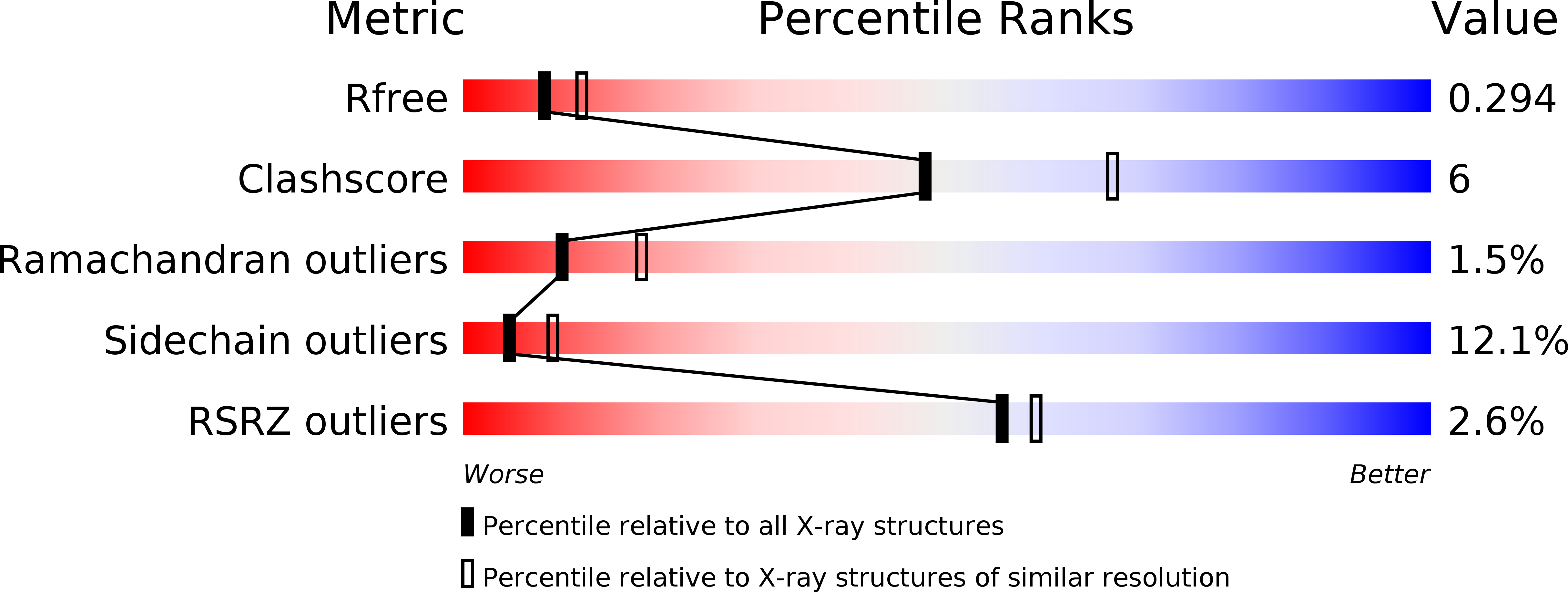Structure and Mechanism of LcpA, a Phosphotransferase That Mediates Glycosylation of a Gram-Positive Bacterial Cell Wall-Anchored Protein.
Siegel, S.D., Amer, B.R., Wu, C., Sawaya, M.R., Gosschalk, J.E., Clubb, R.T., Ton-That, H.(2019) mBio 10
- PubMed: 30782654
- DOI: https://doi.org/10.1128/mBio.01580-18
- Primary Citation of Related Structures:
5V8C - PubMed Abstract:
The widely conserved LytR-CpsA-Psr (LCP) family of enzymes in Gram-positive bacteria is known to attach glycopolymers, including wall teichoic acid, to the cell envelope. However, it is undetermined if these enzymes are capable of catalyzing glycan attachment to surface proteins. In the actinobacterium Actinomyces oris , an LCP homolog here named LcpA is genetically linked to GspA, a glycoprotein that is covalently attached to the bacterial peptidoglycan by the housekeeping sortase SrtA. Here we show by X-ray crystallography that LcpA adopts an α-β-α structural fold, akin to the conserved LCP domain, which harbors characteristic catalytic arginine residues. Consistently, alanine substitution for these residues, R149 and R266, abrogates GspA glycosylation, leading to accumulation of an intermediate form termed GspA LMM , which is also observed in the lcpA mutant. Unlike other LCP proteins characterized to date, LcpA contains a stabilizing disulfide bond, mutations of which severely affect LcpA stability. In line with the established role of disulfide bond formation in oxidative protein folding in A. oris , deletion of vkor , coding for the thiol-disulfide oxidoreductase VKOR, also significantly reduces LcpA stability. Biochemical studies demonstrated that the recombinant LcpA enzyme possesses pyrophosphatase activity, enabling hydrolysis of diphosphate bonds. Furthermore, this recombinant enzyme, which weakly interacts with GspA in solution, catalyzes phosphotransfer to GspA LMM Altogether, the findings support that A. oris LcpA is an archetypal LCP enzyme that glycosylates a cell wall-anchored protein, a process that may be conserved in Actinobacteria , given the conservation of LcpA and GspA in these high-GC-content organisms. IMPORTANCE In Gram-positive bacteria, the conserved LCP family enzymes studied to date are known to attach glycopolymers, including wall teichoic acid, to the cell envelope. It is unknown if these enzymes catalyze glycosylation of surface proteins. We show here in the actinobacterium Actinomyces oris by X-ray crystallography and biochemical analyses that A. oris LcpA is an LCP homolog, possessing pyrophosphatase and phosphotransferase activities known to belong to LCP enzymes that require conserved catalytic Arg residues, while harboring a unique disulfide bond critical for protein stability. Importantly, LcpA mediates glycosylation of the surface protein GspA via phosphotransferase activity. Our studies provide the first experimental evidence of an archetypal LCP enzyme that promotes glycosylation of a cell wall-anchored protein in Gram-positive bacteria.
Organizational Affiliation:
Department of Microbiology and Molecular Genetics, University of Texas Health Science Center, Houston, Texas, USA.

















